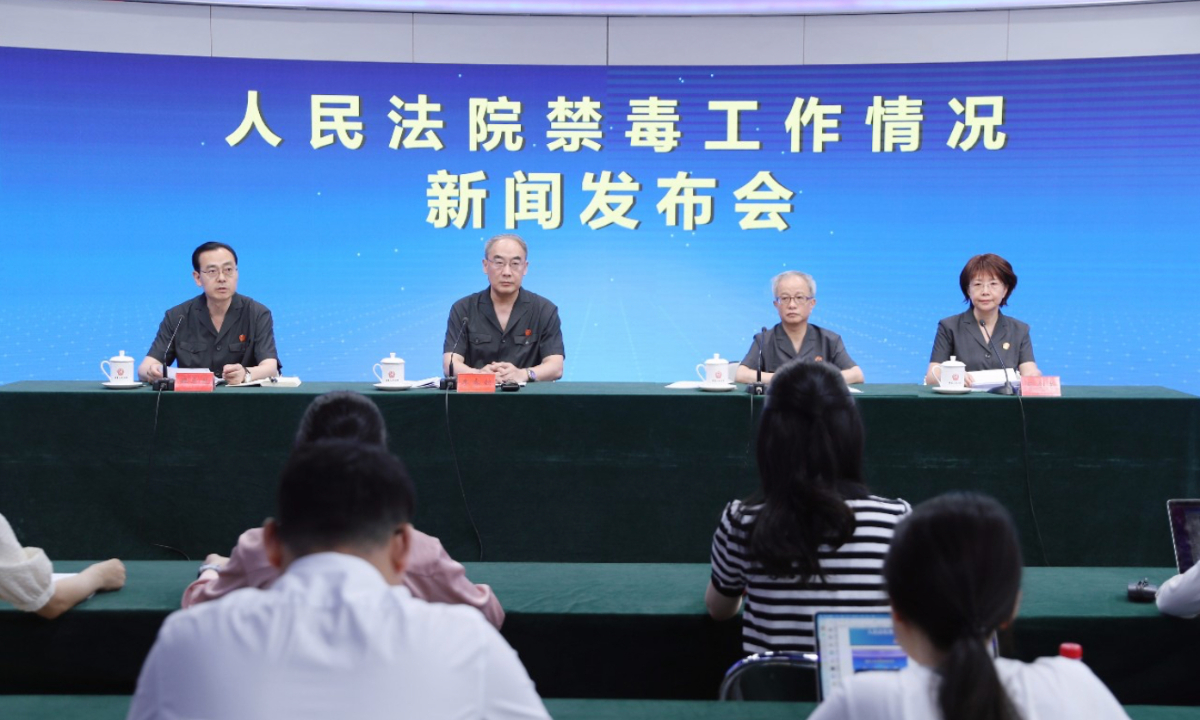New types of drugs spread faster in China, with prominent characteristic of younger demographic in abuse of such substances

A press conference is held by China’s Supreme People’s Court on June 25, 2024. (Photo: Courtesy of China’s Supreme People’s Court)
Despite the steady progress made in China’s anti-drug efforts, the rampant international drug trafficking situation has posed an increasing threat due to the rebound of domestic drug-related crimes, especially the faster spread of new types of drugs and the decreasing age of drug users, China’s judicial organs revealed before the 37th International Day against Drug Abuse and Illicit Trafficking on Wednesday.
According to the Bureau of Drug Rehabilitation Administration under China’s Ministry of Justice, despite the fact that China's anti-drug situation is under control and shows overall improvement, the work of drug rehabilitation is encountering new trends and challenges.
The changes in the types of drugs and drug users have proposed new requirements for rehabilitation work, said the bureau. Drugs used among rehabilitants are becoming increasingly complicated, such as traditional drugs, synthetic drugs, new types of drugs, and even a mix of multiple substances. The difficulty of anti-drug education and treatment has increased significantly, placing higher demands on the operational capacity of police officers.
Besides, the risks associated with safety management in rehabilitation centers have increased. Many of the drug addicts under rehabilitation are sick, disabled, and long-term drug users, raising the difficulty in the management of these people. They have a higher probability of developing cardio-cerebrovascular diseases, severe mental health issues, and violent behaviors, which lead to a higher likelihood of sudden death, suicide, escape, and incidents inside the facilities.
Officials also noted that efforts in the treatment and rehabilitation of personnel consuming non-controlled substances and the drug-using youth population need to be strengthened.
At present, the number of individuals consuming non-controlled addictive substances such as new psychoactive substances and narcotic and psychotropic drugs continues to rise. In response, the drug rehabilitation system is still exploring more targeted methods and approaches for treatment.
Since 2020, the proportion of minors among newly discovered drug abusers can no longer be ignored, posing substantial potential harm to individuals, families, and society. Minors differ significantly from adults in terms of physiological and psychological conditions. Thus, the treatment and rehabilitation of minor drug abusers will be an important area that the authorities need to strengthen in the future.
By the end of 2023, there were 191 pilot detoxification centers nationwide. According to the bureau, more than 1.7 million individuals have been admitted for compulsory segregation for drug rehabilitation, over 120,000 individuals for detoxification and rehabilitation, and more than 350,000 individuals for community rehabilitation.
The drug rehabilitation authority vowed to make full use of the drug detoxification and rehabilitation facilities, especially to strengthen the research on the detoxification and rehabilitation of individuals who use non-controlled substances and adolescent drug users.
Statistics from China’s Supreme People’s Court show that the number of drug-related cases and defendants in China has seen a consecutive eight-year decline after it reached a historical peak in 2015, with the overall positive trend in drug control further consolidated.
In 2023, courts across the country concluded the first-instance trials of 33,401 drug-related cases, with 49,603 defendants being given verdicts, marking year-on-year decreases of 10.41 percent and 11.7 percent, respectively.
From January to May this year, courts nationwide concluded the first-instance trials of 12,996 drug-related cases, with verdicts of 18,262 defendants taking legal effect.
Meanwhile, cases involving addictive substances such as narcotic and psychotropic drugs are on the rise, with significant increases observed in some regions. The younger age group of such substance abusers is more pronounced.
The people’s courts have vowed to severely punish the perpetrators involved in smuggling, manufacturing, large-scale trafficking of drugs, and other primary drug-related crimes, as well as individuals involved in repeated offenses and professional criminals, who have significant subjective malice and pose a greater danger. The people’s courts also vow to increase penalties on those who target minors as primary victims or use minors to commit drug crimes.
The people’s courts also vow to resolutely and strictly punish those who use sedation, anesthesia, and other functions of narcotic and psychotropic drugs to commit crimes such as rape and robbery, in accordance with the laws.
For substances like nitrous oxide, also known as “laughing gas,” and other unregulated substances, the people’s courts vow to punish offenders to ensure powerful crackdowns.
Photos
Related Stories
- 3 suspected drug traffickers repatriated to China from Myanmar
- Drug cases drop for eight years in China
- From shadow to light: China's anti-drug efforts illuminate lives of HIV carriers
- China Coast Guard seizes 8.7 tonnes of narcotics in 5-year crackdown
- Greater Mekong Sub-region countries join hands to curb drug problems
- On the frontlines: a snapshot of China's anti-drug battle
Copyright © 2024 People's Daily Online. All Rights Reserved.









